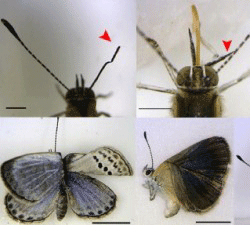http://nuclear-news.net/2013/07/18/radiation-the-most-probable-cause-of-fukushimas-deformed-butterflies/
Japan
Biologist: Radioactivite contamination from Fukushima disaster is
most reasonable explanation for butterfly deaths and abnormalities —
“I think maybe this is a very touchy issue,
politically” http://enenews.com/japan-biologist-radioactivity-from-fukushima-is-most-reasonable-explanation-for-butterfly-deaths-and-abnormalities-i-think-maybe-this-is-a-very-touchy-issue-politically
Source: Nature
Author: Ewen Callaway
Date: 16 July 2013
Author: Ewen Callaway
Date: 16 July 2013
 [...] Last week [...]
biologists studying Fukushima and Chernobyl came together at the annual
meeting of the Society for Molecular Biology and Evolution in Chicago
[...]What Fukushima data do exist are sporadic — and contested. [...]
[...] Last week [...]
biologists studying Fukushima and Chernobyl came together at the annual
meeting of the Society for Molecular Biology and Evolution in Chicago
[...]What Fukushima data do exist are sporadic — and contested. [...]
[...] Insects collected in May [2011] showed few problems, but their
lab-reared offspring had many abnormalities, such as misshapen wings and
aberrant eyespots, and many died as pupae (A. Hiyama et al. Sci. Rep.
2, 570; 2012). Among the September-collected butterflies, more than half
of the progeny showed such defects.
[...] “You can come up with alternative explanations, but I think the hypothesis that radiation caused death and abnormalities is the most reasonable,” [Joji Otaki, an ecologist at the University of the Ryukyus in Nishihara, Japan] says.
Tim Mousseau, an evolutionary geneticist at the University of South Carolina in Columbia [...] is heading to Fukushima this week to begin his third season of field work [...] His team saw die-offs in some insects and declining numbers of some bird populations [...]
For funding, Otaki says he has had to turn mostly to private foundations. “I think maybe this is a very touchy issue, politically,” he says.[...] The Department of Energy has largely stopped funding its research programme in low-dose exposure, and the National Science Foundation and the National Institutes of Health have awarded few grants [...]
See also: Japan Scientists: Truly unusual deformities in Fukushima — Forests may be evolving into different ecosystems — “There’s been a sudden, large change”
[...] “You can come up with alternative explanations, but I think the hypothesis that radiation caused death and abnormalities is the most reasonable,” [Joji Otaki, an ecologist at the University of the Ryukyus in Nishihara, Japan] says.
Tim Mousseau, an evolutionary geneticist at the University of South Carolina in Columbia [...] is heading to Fukushima this week to begin his third season of field work [...] His team saw die-offs in some insects and declining numbers of some bird populations [...]
For funding, Otaki says he has had to turn mostly to private foundations. “I think maybe this is a very touchy issue, politically,” he says.[...] The Department of Energy has largely stopped funding its research programme in low-dose exposure, and the National Science Foundation and the National Institutes of Health have awarded few grants [...]
See also: Japan Scientists: Truly unusual deformities in Fukushima — Forests may be evolving into different ecosystems — “There’s been a sudden, large change”
No comments:
Post a Comment